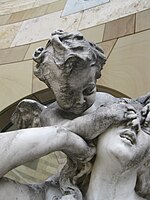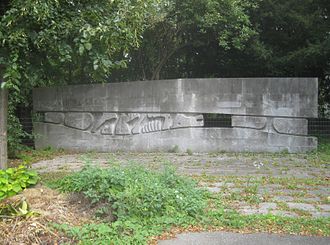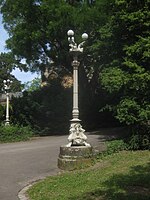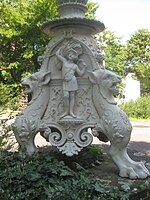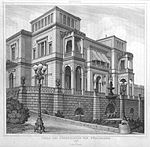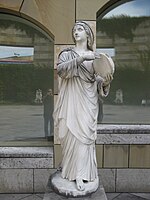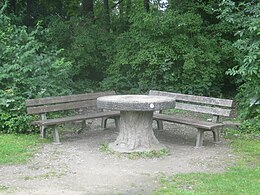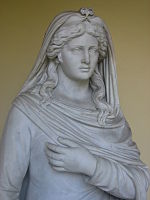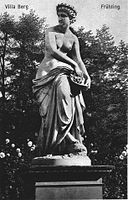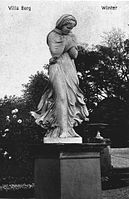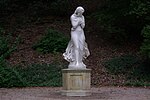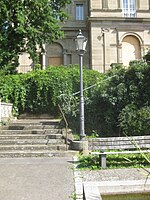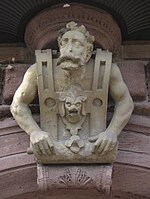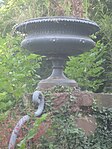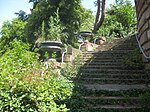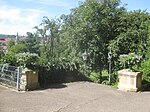Villa Berg (works of art)
Many works of art were exhibited at the Villa Berg in Stuttgart, a large part of which has been lost, destroyed or sold. Some have been preserved in their original location, some objects can be viewed in the municipal lapidarium and in the rotunda of the Staatsgalerie in Stuttgart, and some are stored in municipal offices.
In the following, selected works of art are described that formerly belonged or still belong to Villa Berg or Park Villa Berg. The works are listed alphabetically by artist and current location .
According to artists
The works are listed for each artist according to the order of the year of origin, if the year of origin is unknown, after the works with a year of origin.
Donato Barcaglia
Love is blind (1884)
Figurative representation of the proverb “Love makes blind” in a classicistic round sculpture by Donato Barcaglia (1849–1930) on a round, profiled plinth with rose bush , marble, cuboid stone base, smaller than life, inscribed on the base: “D. Barcaglia / Milano / 1884 ", year of origin 1884, after 1925: Stuttgart, Villa Berg , upper landing of the lower staircase, after World War II : Stuttgart, Städtisches Lapidarium , today: Stuttgart, Staatsgalerie , Rotunda (on loan from the Städtisches Lapidarium, inventory number 70 ), State of preservation: missing toes on the woman's left foot, putti with broken wings and feet, weathered rose bushes, blackening.
A naked beauty of sensual femininity fights against the attack of a winged and curly cupid boy who attacks her from behind and attaches himself to her back. Her face, framed by flowing Botticelli ringlets, reflects passion, her half-open mouth reflects the breathlessness of desire. The putto closes her eyes with his fat little fingers, which do not want to see anything because she dreams of her lover.
The statue was given to the city of Stuttgart as a gift for the Villa Berg by city councilor Ella Ehni in the late 1920s .
Literature: Gohl 2007 , page 50, 120-121; Wais 1954 , 107.
Otto Baum
Memorial (1960)
Other work titles: memorial for the fallen students , memorial for the fallen students of the business school , memorial for the fallen students . Double-sided wall relief by Otto Baum , masonry shell limestone, height 2.40 m, length 10 m, depth 0.60 m, signed front lower left: "Baum", inscription front upper right: "1914 1918 1939 1945", year of origin 1960, Stuttgart , at the east end of the Park Villa Berg , in the courtyard of the Johann-Friedrich-von-Cotta-Schule, state of preservation: masonry broken apart in the middle, the fracture point filled with mortar, the back almost completely covered with graffiti, the original coloring has disappeared.
The Johann-Friedrich-von-Cotta-Schule houses several types of schools, including a business high school, and emerged from a business school that had existed since 1937. In 1959 the school moved into the new building in Park Villa Berg, and one year later in 1960 the memorial for the fallen students was erected. It is not known for what current occasion and on whose instigation the memorial was only erected 15 years after the last war. It is all the more astonishing that today, 65 years after the war, it is being left to decay.
The monumental “Wailing Wall” expresses the speechlessness after the horror of the two world wars. No words of remembrance, no names of the fallen, only the bare years of the wars can be found on the wall, and the two stone reliefs only speak in ciphers. Like the jaws of an all-devouring crocodile, the undulating foundation wall and the rectangular ceiling beams, which are crowned by heavy stone blocks, gape apart and mercilessly crush whatever gets between their “teeth”. In addition to bulky, rounded, rectangular shapes that defy any concrete interpretation, bones - skull, chest and limbs - seem to be subjected to the merciless work of crushing. While the front relief symbolizes "abstractly the creature battered by the war", the "flames and debris on the back" remind of "the material destruction" of the war.
The “memorial”, intended as a “memorial”, does not honor anyone; in its pitiful state it is rather a stone reminder not to deal with cultural goods and the memory of the dead of the world wars.
Literature: Baum 2000 , page 74, 185, 198; Gohl 2010 , page 25; Stroebel 1963 .
Georg Beer
Base of the weather witch (1584–1593)
Base of a weather vane with leaf ornamentation by Georg Beer , the builder of the New Lusthaus , sandstone, height 75 cm, year of construction 1584–1593, originally: Stuttgart, Neues Lusthaus , 1853: Stuttgart, Villa Berg , 1890: Collection "Vaterländischer Altert becoming", 1935: North-east tower of the old castle, today: Stuttgart, municipal lapidarium , inventory number 23, state of preservation: weathered, mossed beyond recognition.
The base originally belonged to one of two 3 meter high copper, gold-painted weather vanes. One of the two weather vanes was lost during the renovation of the New Lusthaus in 1844/1845, the other was destroyed in World War II.
Simson with the city gates , the load carrier console , the two load carrier consoles and the base of the weather witch are among the components that Crown Prince Karl, on the advice of Friedrich Hackländer, had when converting the New Lusthaus into the court theater and later built it into the Villa Berg.
Literature: Hackländer 1878 , pages 78–79; Schmid 2006 , page 82; Wais 1951 , pp. 330-331; Wais 1954 , p. 124; Walcher 1887 , No. 1, pages 5-7, No. 5, page 8; Weber-Karge 1989 , pages 22-23.
Jean-Baptiste Joseph Debay
Four Seasons (before 1858)
- South terrace, around 1930, with seasons and boys' figures
- South terrace, around 1931, left: summer, autumn and winter, middle and right: five boys' figures
- South terrace, around 1930, with bowl of turkey , in the background spring (left) and summer (right)
Allegorical statues of the four seasons by Jean-Baptiste Joseph Debay, father (1779–1863) or son (1802–1862), material unknown, life-size, year of origin before 1858, originally: Stuttgart, Villa Berg , Halbachteckplatz of the south terrace, today: lost.
- Spring: woman with flowers in her hair.
- Summer: woman with wreath of ears, sickle and sheaf in hand.
- Autumn: Woman with a wreath of grapes in her hair and with a drinking bowl.
- Winter: Woman, "tightly wrapped, freezing and shivering as if from the cold".
All information is taken from Büchele 1858 .
Literature: Büchele 1858 , page 299; Gohl 2010 , pages 39, 103, 104.
Allegorical figures of boys (before 1858)
- South terrace, around 1930, with seasons and boys' figures
Six allegorical boy figures by Jean-Baptiste Joseph Debay, father (1779–1863) or son (1802–1862), material unknown, life-size, year of origin before 1858, originally: Stuttgart, Villa Berg , Halbachteckplatz of the south terrace, today: lost.
According to Karl Büchele, the boys' statues symbolize the main directions of science, art, trade and commerce:
- Allegory of the natural sciences "examining a hand-held shell, next to it as attributes globe and scrolls"
- Allegory of stone and metal sculpture "leaning against an anvil, with a hammer in one hand and an amphora in the other"
- Allegory of the sculpture "with a torso"
- Allegory of shipping "with flying hair and sea equipment as attributes"
- Allegory of Agriculture
- Allegory of Commerce
All information is taken from Büchele 1858 .
Literature: Büchele 1858 , page 299; Gohl 2010 , pages 39, 103; Schümann 1973 , page 72.
Albert Güldenstein
Nymph Fountain (1851)
Bronze casting in the Wasseralfingen ironworks based on models by Albert Güldenstein based on a design by Christian Friedrich von Leins , the architect of Villa Berg , year of construction 1851, Stuttgart, Villa Berg, east facade. Conservation status: good, the antlers of one deer have broken off.
Half of the three-shell fountain protrudes over the east terrace of Villa Berg , so that its water could flow into the basin at ground level in front of the substructure. The lower shell bears a cross-shaped stone base with four console capitals on which the Württemberg heraldic animals are enthroned, two lions and two deer, the lions in threatening posture and with their jaws torn open and alternating with two roaring deer. Above the middle shell, four naked nymphs crowd around the richly profiled fountain stick, which is decorated with fish, mussels and water snails. You have just got out of the bath and are untying your flowing hair again. A naked genius stands casually on the upper shell. With his right arm he balances an amphora on his head and with the other he pats a wing-swinging swan, which, with its beak open, eagerly winds its long neck towards the amphora in order to catch a jet of water from it.
See also: putti reliefs and dolphin reliefs .
Literature: B 1007 Bü 1141 ; Bach 1900 , page 319; Büchele 1858 , pages 297-298, 304; Dehio 1993 , p. 760; Gohl 2007 , pages 32-36, 172; Müller 1851 ; NN 1925 , page 12; Petzold 1989 ; Wais 1954 , page 60; Wenger 2003 , page 33.
Driveway candelabra (1853)
Four candelabra based on a design by Christian Friedrich von Leins or Paul Wirth (1821–1870). Figure and animal models by Albert Güldenstein , ornaments by the Wasseralfinger modeller Jakob Offinger, burnished cast iron, cast in the Wasseralfingen ironworks, on a double-stepped, barrel-shaped sandstone base, height without base approx. 390 cm, year of creation 1853 (cast), Stuttgart, villa Mountain , at the ends of the driveway to the south terrace, condition: good, various rust spots, feet partially overgrown by plants, one foot partially sprayed with red paint.
The candelabra rest on a richly ornamented, triangular base with a chimera on each corner and allegorical boys' figures on the sides, which represent science, war and agriculture (allegories of the teaching, military and nutritional status). The chimeras carry the head of a panther with a long, pointed antelope horn growing out of its skull. The horns of each two chimeras are held together by a ring at the top so that they form an arch over the boys' figures. The chimera head turns into a swollen chest, which finally mutates into a huge paw.
The round shaft is initially profiled several times and decorated with plant ornaments throughout. The fluted main part merges into a narrow capital decorated with leaves and rosettes, the volute-like consoles of which are crowned by lions' heads. Above the capital, the shaft widens to a plate on which the three lampholders are enthroned. The kneeling nymphs stretch their bare chests upwards and hold up the lanterns with the frosted glass balls with their wide-reaching arms.
Literature: B 1007 Bü 1141 ; Büchele 1858 , page 298; Hackländer 1878 , page 194; Müller 1851 , page 283; NN 1854.1 , page 344; NN 1854.1 , page 26; Schümann 1973 , page 85, fig. 55.
Two sitting dogs (before 1858)
Zinc casting by Wilhelm Pelargus based on models by Albert Güldenstein , painted over in black , life-size images of Crown Prince Karl's favorite dogs, year of origin before 1858, originally: Stuttgart, Villa Berg , at the foot of the two stairs to the western terrace, lost since the Second World War.
Illustration: West staircase of Villa Berg with the dogs sitting, around 1930.
Literature: AKL ; Brösamlen 1939 , pages 82, 83; Büchele 1858 , page 301; Gohl 2007 , page 37, illustrations: pages 41–42, 124; Kress 1987 , p. 105; NN 1925 , page 13.
Four reliefs (before 1858)
Four reliefs with ancient mythological scenes, made before 1858, originally: Stuttgart, Villa Berg , destroyed in the Second World War.
Literature: AKL ; Büchele 1858 , page 303.
Donor (1863)
Female figure, cast zinc by Wilhelm Pelargus based on a model by Albert Güldenstein , created in 1863, originally: Stuttgart, Villa Berg , now lost.
Literature: AKL ; E 14 Bü 33 , No. 25; E 14 Bü 203 , 1861-1865, No. 39.
Ludwig von Hofer
Of Ludwig von Hofer's works for Villa Berg, only the bust of Diana of Versailles and the statues of Ceres and Flora have survived . The bust of Apollo Belvedere and the busts of Ceres and Flora, however, have been destroyed or lost.
Diana of Versailles (1849)
Classicist bust of Diana of Versailles by Ludwig von Hofer , round, profiled base, marble, 76 × 47 × 30 cm, unmarked, year of origin 1849 or earlier, originally: Stuttgart, Villa Berg , on the side walls of the lower vestibule, 1982: Stuttgart, Villa Gemmingen, in the colonnades, 1995: Stuttgart, Städtisches Lapidarium , inventory number 64, from 2006 at the latest: no longer in the lapidarium, probably in the Stuttgart city archive, state of preservation: tip of the nose broken off.
“Diana is shown in profile with her head turned to the right. Her curly hair is tied back and adorned with a diadem above the base of the forehead. The upper body is clad in a pleated, close-fitting, sleeveless robe. A panel of fabric runs from the left shoulder like a sash over the left chest. From her posture, she appears to be raising her right arm while the left is hanging down. The back is not worked out. "
Literature: Büchele 1858 , page 304; Peschel 2009 , pages 215-216; Wais 1954 , page 106, image 12.
Ceres (1851-1854)
Classicistic round sculpture of Ceres by Ludwig von Hofer on a round plinth , marble, cuboid stone base, 177 × 68 × 53 cm (life-size), unmarked, year of creation 1851–1854 (?), Originally: Stuttgart, Villa Berg , rear wall of the lower vestibule, after World War II: Stuttgart, Städtisches Lapidarium , today: Stuttgart, Staatsgalerie , Rotunde (on loan from the Städtisches Lapidarium, inventory number 72), state of preservation: good, but blackening and slight surface corrosion.
Ceres, a matron with a classically beautiful face and strict, tightly knotted hairstyle, pensively turns her gaze to the side. She is dressed in a foot-length, pleated tunic and a toga that falls well below the knees. The left breast is bare, the right arm wrapped in the upper garment. In her left hand she holds the attributes of the Roman goddess of fertility, a sheaf of ears with two poppy seed capsules.
Literature: Brösamlen 1939 , page 84; Büchele 1858 , page 303; Gohl 2007 , page 54; NN 1925 , page 14; Peschel 2009 , pages 241-242; Schümann 1973 , pages 61-62; Wais 1954 , 107.
Flora (around 1855)
Classicistic round sculpture of Flora by Ludwig von Hofer on a round plinth , Carrara marble, cuboid stone base, 178 × 60 × 59 cm (life-size), unmarked, year of creation around 1855, originally: Stuttgart, Villa Berg , rear wall of the lower vestibule, after the second World War: Stuttgart, Städtisches Lapidarium , today: Stuttgart, Staatsgalerie , Rotunda (on loan from the Städtisches Lapidarium, inventory number 67), state of preservation: good, but the lower phalanges of the right hand are missing, blackening and slight surface corrosion.
Flora, a young woman of slim, girlish stature, with sensual classic facial features and a forward-looking gaze, wears the wreath of flowers, one of the insignia of the Roman goddess of flowering and spring, over her curly head of hair tied back into a bun. She is dressed in a foot-length, richly pleated tunic and a knee-length toga. She stretches out her right hand towards the viewer as if in greeting, and in the other hand she holds a bouquet of spring flowers, another sign of her divine mission.
Literature: Brösamlen 1939 , page 84; Büchele 1858 , page 303; Gohl 2007 , page 54; NN 1925 , page 14; Peschel 2009 , pages 243-244; Schümann 1973 , pages 61-62; Wais 1954 , 107.
Heinrich Maximilian Imhof
Miriam (1859)
Other work title: The Tambourine Player; The music. - Classicistic round sculpture of the biblical prophetess Miriam by Heinrich Maximilian Imhof on a round plinth , Carrara marble, cuboid stone base, life-size, inscribed on the base: “HEINR. IN THE YARD. FEC. ROMA / 1859 ", year of origin 1859, originally: Stuttgart, Villa Berg , lower vestibule, after the Second World War: Stuttgart, Städtisches Lapidarium , today: Stuttgart, Staatsgalerie , Rotunda (on loan from the Städtisches Lapidarium, inventory number 69), state of preservation: good, however, phalanges of the fingers on the right hand are missing, blackening.
When leaving Egypt, after crossing the Red Sea, Miriam led the dance of joy and the singing of the women. The statue shows a dancer beating the tambourine with a classic profile and in antique clothing. She modestly covers her curls with a headscarf.
The Württemberg crown prince couple Karl and Olga met the artist who lives in Rome during his visit to Rome in 1857 and ordered the two statues Ruth and Miriam on site. After their completion in 1859, they were installed at Villa Berg the next year .
Literature: Gohl 2007 , page 55; Leins 1889 , page 92 (illustration); NN 1925 , page 14; Schümann 1973 , pages 62, 64; Wais 1954 , 107.
Ruth (1859)
Another work title: The Gleaner. - Classicistic round sculpture of Moabite Ruth by Heinrich Maximilian Imhof on a round plinth , Carrara marble, cuboid stone base, life-size, inscribed on the base: “HEINR. IMHOF FEC. ROMA 1859 “, year of origin 1859, originally: Stuttgart, Villa Berg , lower vestibule, after the Second World War: Stuttgart, Städtisches Lapidarium , today: Stuttgart, Staatsgalerie , Rotunda (on loan from the Städtisches Lapidarium, inventory number 71), condition: good, however missing a link on a finger, chipping on the plinth, blackening.
After the death of her Jewish husband, Ruth moved from Moab to Israel and worked there as a gleaner for a relative of her husband. The statue shows Ruth collecting ears of corn and wrapping it in a fold in her garment. Ruth is shown as a young woman in antique clothes and a headscarf. She turns her gaze attentively to the ground, where she finds the ears of wheat to be picked up.
The Württemberg crown prince couple Karl and Olga met the artist who lives in Rome during his visit to Rome in 1857 and ordered the two statues Ruth and Miriam on site. After their completion in 1859, they were installed at Villa Berg the next year .
Literature: Gohl 2007 , page 55; NN 1925 , page 14; Schümann 1973 , pages 62, 64; Wais 1954 , 107.
Hermann Jung
Farewell to a warrior (after 1918)
Model of the war memorial in Filderstadt-Bernhausen by the sculptor Hermann Jung (1876 – before 1939), on a rectangular plinth , material and dimensions unknown, year of creation after 1918, formerly: Stuttgart, Villa Berg , west parterre, in one of the three west-east arcades , today: lost.
After the First World War , the then independent Bernhausen dedicated a war memorial to “his fallen sons”, the model of which was later set up in the park of Villa Berg and is now lost. The war memorial itself is located in the churchyard of the Jakobuskirche in Filderstadt-Bernhausen.
The model of the group of figures depicts the dramatic farewell of a soldier before going to war. In the center of the group stands the soldier in front of his horse ready to march, dressed in field uniform and steel helmet. He points into the distance with one arm as a sign of his impending, inevitable departure. His mourning wife is grouped around him, a teenage daughter who pleadingly holds up her hands to her mother, and a naked baby sitting on the floor to one side. The innocent child has no inkling of the suffering of his parents and his sister and the horse's forehead grazes playfully as it pulls its head down between its thighs as if bowed in grief.
Literature: Brösamlen 1939 , page 84; Gohl 2007 , page 140; Furrier 2009 .
Albert Juerss & Crotogino
Stone table (around 1860)
Stone table, stone cast by the A. Jürss & Crotogino stone foundry in Rostock, height approx. 86 cm, diameter approx. 126 cm, inscribed on the bottom of the table: "Steingiesserei / von / A. Jürss Crotogino / ROSTOCK", year of origin around 1860, Stuttgart, Villa Berg , ground floor in front of the west facade, condition: good.
The stone table anchored in the ground, around which two benches are now grouped, stands in front of a rectangular bulge, formerly provided with smooth screed, on the southern edge of the former flower garden. The thick, round table top, smooth at the top, roughly hewn along the edge, rests on a broad metatarsus that is modeled on a deeply furrowed tree stump.
Literature: none.
Kolyvan vessels
Siberian sumptuous bowl (1850-1852)
Other work title: Jasper bowl; Splendid jasper bowl. - Extending, profiled sumptuous bowl with funnel-shaped base on a square plinth , made of shiny, polished, green-yellow banded Siberian jasper, cuboid limestone base, diameter 115 cm, height of the bowl 85 cm, base height 40 cm, year of origin 1850–1852, originally: Stuttgart, Villa Berg , lower vestibule, today: Stuttgart, Städtisches Lapidarium , inventory number 4. The designation proves the year of origin and that the vase was made in the South Siberian stone cutting shop Kolywan (like the volute amphora from 1862 and the volute amphora from 1870 ), state of preservation: good, cracks on Glued to the base and to the body.
Tsar Nikolaus I gave the sumptuous bowl to his daughter Olga in 1853 when she moved into the Villa Berg , where she lived with her husband, the Württemberg Crown Prince Karl , until he took office in 1864.
For comparison: the largest polished jasper is an oval Kolyvan bowl in the Hermitage in Saint Petersburg ("Tsarina of bowls") with a size of 5.04 × 3.22 meters, which is 4–5 times the size of the sumptuous bowl.
Literature: Brösamlen 1939 , page 84; Gohl 2007 , page 161; Leins 1889 , pages 92, 93 (images with the Siberian sumptuous bowl); NN 1925 , page 14; Schmid 2006 , pages 38-39; Schümann 1973 , page 62; Wais 1954 , 93.
Volute amphora (1862)
Volute amphora on a cuboid base, vulcanite (trade name Korgon-Porphyry ), vase and base deep blue, vase belly partly with dark, cloudy spots, diameter 40 cm, height of the vase 100 cm, base height 55 cm, year of origin 1859–1862, originally: Stuttgart, Villa Berg , Dining room, today: Stuttgart, Städtisches Lapidarium , inventory number 61. Counterpart to the volute amphora from 1870 . The name indicates the year of origin and that the vase was made in the South Siberian stone cutting shop Kolywan (like its counterpart and the Siberian sumptuous bowl ).
Originally probably owned by Queen Olga .
Literature: Gohl 2007 , pages 56, 161; Schmid 2006 , page 55; Wais 1954 , p. 106.
Volute amphora (1870)
Volute amphora on a cuboid base, vulcanite (trade name Korgon-Porphyr ), vase and base deep blue, diameter 40 cm, height of the vase 100 cm, base height 55 cm, year of origin 1869–1870, originally: Stuttgart, Villa Berg , dining room, today: Stuttgart, Municipal lapidarium , inventory number 63. Counterpart to the volute amphora from 1862 . The name indicates the year of origin and that the vase was made in the South Siberian stone cutting shop Kolywan (like its counterpart and the Siberian sumptuous bowl ).
Originally probably owned by Queen Olga .
Literature: Gohl 2007 , pages 56, 161; Schmid 2006 , page 55; Wais 1954 , p. 106.
Joseph von Kopf
Ingeborg with the falcon (1857–1873)
Classicistic round sculpture of a female figure by Joseph von Kopf on a round plinth , marble, height 215 cm, unmarked, year of creation between 1857 and 1873, not in the 1998 Kratt catalog , originally: Stuttgart, Villa Berg , today: Stuttgart, Städtisches Lapidarium , inventory number 65, Conservation status: good, but the falcon is missing its head.
An antique clad woman with a classically beautiful face and an artistic hairstyle turns head-on towards the viewer. With her right hand she gathers her outer garment, she crosses her left arm in front of her chest so that the hand touches the heart. A falcon sits at her feet, as if it were following its mistress at every turn.
Literature: Gohl 2007 , page 161; Schmid 2006 , page 55; Wais 1954 , 107.
Four Seasons (1859–1862)
Replica of the Allegory of Winter, Bad Freienwalde
Allegorical statues of the four seasons, classicistic round sculptures on a round plinth , marble, on a profiled stone base, life-size, year of origin: erected in spring and summer 1859, completed in autumn and winter 1862, catalog numbers see below, originally: Stuttgart, Villa Berg , two each on the right and left from the middle portico on the west ground floor, around 1925: on the south terrace; destroyed in World War II.
- Spring: A young woman dressed in antiquity, naked except for her hips and crowned with a wreath of flowers, sprinkles, like a sower, the seeds, flowers from a basket onto the corridor.
- Summer: A young woman, dressed in an antique under and outer garment, a bundle of corn stalks under her arm and a sickle in her hand, pulls a veil over her spiked head to protect her from the heat of summer.
- Autumn: A bare-breasted young woman in antique clothing presents a bowl of autumn fruits with her arm raised.
- Winter: A young woman, "walking in a storm with a backward-flying robe. I modeled this figure half-life-size in one go, creating the nakedness and the drapery at the same time. [...] The movement of walking against the wind seemed to me successful; the figure holds the robe with his arms crossed over his chest. In the fluttering dress I partly hid a naked cupid in the shape of a putti, who was freezing to express what I was thinking. I think this figure is and is the best of the four later very often made to order by me in all sizes. " - A replica by the artist himself from 1862 is in Bad Freienwalde .
Literature: Büchele 1858 , page 299; Courtin 1870 , page 33 and plate 3; Gohl 2007 , page 30 (figure), 39, 103, 109–112; Kratt 1998 , pages 9-11, 145-148, catalog numbers 8a, 9a, 10a, 11b; Kopf 1899 , pages 194, 254, Frühling: pages 151-152, 157, 159-160, 166, 208; Summer (partly under the work title "Ruth"): pages 133-134, 138-140, 144-145; Autumn: Pages 168-170, 173, 180, 199, 208, 232, 420; Winter: pp. 173, 180, 199, 208-210, 212, 214, 247; Leins 1889 , page 90 (illustration), 91; NN 1925 , page 13.
Bust of King Karl and Queen Olga (1863)
Bust of King Karl and Queen Olga , material unknown, year of origin 1863, Kratt 1998 : catalog number 21b (Olga), 22b (Karl), from 1925: Stuttgart, Villa Berg , in the niches next to the west grotto, today: private property. Conservation status: unknown.
Literature: Gohl 2007 , page 41, 143; Kopf 1899 , page 254, 257-258.
Christian Friedrich von Leins
Stair candelabra (1853)
Four candelabra based on a design by Christian Friedrich von Leins , cast iron, cast in the Hüttenwerke Wasseralfingen, on a barrel-shaped sandstone plinth, height without plinth approx. 365 cm, year of construction 1853 (cast), Stuttgart, Villa Berg , at the entrance of the two stairs to the south terrace , State of preservation: good, glass panes of the lanterns partially destroyed.
The simple candelabra consists of a round shaft, which is thicker and smooth in the lower part and thinner and fluted in the upper part. The lower shaft is profiled by a few rings and is initially decorated with a leaf band and in the middle with a rosette band. The lanterns are hexagonal bodies glazed on all sides, tapering downwards and ending with a double roof and a pointed ball.
Literature: B 1007 Bü 1141 .
Franz Linden
Water-giving nymph (from around 1910)
Naked female nymph on a square plinth by the Düsseldorf sculptor Franz Linden (1873-1923), bronze, low rectangular stone plinth, height without plinth approx. 165 cm, year of origin around 1910, inscribed on the plinth on the left: "FRANZ LINDEN / DUESSELDORF." , originally: Stuttgart, Villa Berg , on the fountain in the rose garden, since around 1980: on the fountain in the south garden of Villa Berg on the underground car park of Südwestrundfunk , today: Stuttgart, Pragfriedhof , to the left of the historic morgue.
The naked nymph originally stood as a fountain figure in the rose garden in front of the backdrop of the garden belvedere, later also as a fountain figure in the south garden. She spreads her arms and lets the water trickle down into the fountain in fine jets from the two mussels she is holding. At its current location in the Prague cemetery, it has lost its function as a fountain figure.
The incorrect attribution to Albert Güldenstein , which can only be found in Böhm 2004 , is probably due to a confusion between the fountain and the nymph fountain on the east facade of the Villa Berg, the figural decoration of which comes from Güldenstein.
Literature: Böhm 2004 , page 35; Gohl 2007 , page 116.
Fritz Melis
Circling Eagles (1967)
Sculpture by Franz Melis (1913–1982), executed by Metall-Haug in Esslingen, copper sheet and brass, height 550 cm, year of origin 1967, Stuttgart, Villa Berg , near the east facade, state of preservation: damaged surfaces, burst seams, smeared with graffiti.
An impartial observer of the sculpture might think that he has the accident of two model airplanes in front of his eyes: after a dive, one digs its wing deep into the earth, while the other tries in vain to evade and tears it away with its wing. However, the title of the work “Circulating Eagles” suggests a different interpretation of the sculpture rising into the sky. As if in a snapshot, the artist captures the circling flight movement of two origami-like stylized birds, which seem to collide at one point on their powerful, wide-spread wings, and which in reality must be imagined high in the air. The eagle's bodies have had a gray patina, their eyes and beaks are made of brass and have a golden sheen.
Many other works by Fritz Melis are on public display in Stuttgart, including the pelican fountain in the upper palace garden (at the hotel at the palace garden) and the flamingo fountain in the middle palace garden (at the café by the lake).
Literature: Gohl 2010 , page 43; Melis 1983 .
Francesco Pozzi
Jupiter and Antiope (1828)
Fully plastic marble group by Francesco Pozzi (1779–1844) on an oval plinth with Latin inscription, height 1.50 cm, inscribed on Jupiter's strap: “F Pozzi F. il 1828.”, year of origin 1828, originally: Stuttgart, Villa Berg , in the Grotto of the west facade, 2010: auctioned by Südwestrundfunk in an auction at Nagel Auctions . Conservation condition: restored, bumped, supplemented.
Jupiter , the father of the gods , with his heraldic animal, a mighty eagle with divine lightning between its claws, took on the shape of a voluptuous satyr , with goat feet and horns, naked except for the lion's skin that is in his shoulder strap, around Antiope to ambush and seduce the beautiful daughter of King Nykteus in her sleep. The luscious, sleepy beauty, whose shame is only poorly covered by a cloth, lets the arm with the panpipe drop impotently, she puts the other arm around the lover, who surrounds her with his goat legs and gesticulates to her.
The inscription on the face of the plinth does not match the passage given in Nagel 2010 by Ovid (Metamorphoses, Book 6, Verse 110/111).
Literature: Brösamlen 1939 , pages 83-84; Büchele 1858 , page 301; Gohl 2007 , pages 41, 105, 143; Nagel 2010 ; NN 1925 , pages 13-14; Wais 1954 , p. 13.
Wilhelm Rösch
Muckenbüble (1883)
Actual title of the work: “Boy in Danger”, popularly “Muckenbüble”. - Bronze cast based on the model by Wilhelm Rösch , life-size, year of origin 1883 (model), 1886 (cast), originally: Stuttgart, Park of Villa Berg , between the lower pergola and the half moon lake, today: Stuttgart, Städtisches Lapidarium , inventory number 49.
A naked boy, who stands on one leg like a flamingo and pulls the other up bent, turns back in a screwed position, stretching his left arm with the towel behind him to keep his balance, and with his right arm wide to reach one To kill an insect that hurt his thigh.
Literature: Gohl 2007 , page 113; NN 1886 ; Schmid 2006 , page 4, 50; Wais 1954 , p. 102.
Sem Schlör
Samson with the city gates (1586/1587)
Relief by Sem Schlör (around 1530–1597 / 1598), sandstone, height approx. 115 cm, width approx. 51 cm, year of origin 1586/1587, originally: Stuttgart, Neues Lusthaus , 1853: Stuttgart, Villa Berg , grotto in the west facade , 1949: Stuttgart, Städtisches Lapidarium , inventory number 23.
The relief depicts a scene from the life of Samson , as described in the Book of Judges , chapter 16, verses 1-3: “Samson went to Gaza and saw a whore there and came to her. Then it was said to the Gazites: Samson has come in. And they surrounded him and lay in wait for him all night in the city of Tor, and were silent all night, saying, Wait; tomorrow, when it gets light, we want to strangle him. But Samson lay until midnight. So he got up at midnight and grabbed both doors of the city gate and the post and lifted them with the bolts and put them on his shoulders and carried them up to the top of the mountain in front of Hebron. ”(New English Bible from 1912).
Simson with the city gates , the load carrier console , the two load carrier consoles and the base of the weather witch are among the components that Crown Prince Karl, on the advice of Friedrich Hackländer, had when converting the New Lusthaus into the court theater and later built it into the Villa Berg.
Literature: GU 20 Bü 166 ; Butcher 1971 ; Hackländer 1878 , pages 78-79; Schmid 2006 , pages 43-44; Wais 1954 , pp. 96-97; Walcher 1887 , issue 1, page 7; Weber-Karge 1989 , pages 25, 27-28.
Load carrier bracket (around 1590)
Console with load carrier as Atlant by Sem Schlör (around 1530–1597 / 1598), sandstone, height 77 cm, year of origin around 1590, originally: Stuttgart, Neues Lusthaus, on the four corners of the cornice, 1853: Stuttgart, Villa Berg , under the Nymph fountain on the east facade, state of preservation: nose of the atlas chopped off, some abrasions on the right arm.
The half-length figure of a naked man squeezes into a support frame, bending over and thus adapts to the volute shape of the console. With his muscular arms the porter rolls the front end of the volute like a scroll. His angular, manly face is framed by rich, curly hair, chin, cheekbones and expansive mustache. The two wide shoulder straps of the support frame, which roll out upwards in a volute, are connected in the middle by a transverse strap that carries the mask of a stylized animal head. The console with its atlas sits like a keystone on the archway, which ends with a volute-like scroll, and seems to support the nymph fountain above.
Simson with the city gates , the load carrier console , the two load carrier consoles and the base of the weather witch are among the components that Crown Prince Karl, on the advice of Friedrich Hackländer, had when converting the New Lusthaus into the court theater and later built it into the Villa Berg.
Literature: Hackländer 1878 , pages 78–79; Wais 1951 , p. 332; Walcher 1887 , issue 1, page 7; Weber-Karge 1989 , pages 27-28.
Two load-bearing consoles, a pilaster capital and a stag console (around 1590)
Two consoles with load carriers as Atlant by Sem Schlör (around 1530–1597 / 1598), part of a pilaster capital and a stag console by Georg Beer , the builder of the New Lusthaus , sandstone, heights: load carrier approx. 77 cm, capital part approx. 53 cm, Deer console approx. 75 cm, year of manufacture around 1590, originally: Stuttgart, Neues Lusthaus, 1853: Stuttgart, Villa Berg , western park, on the northern staircases to the lake, after World War II: Stuttgart, municipal lapidarium , inventory number 305a, b (illustration : Load carrier 1 and pilaster capital), inventory number 305c, d (illustration: load carrier 2 and deer console) Condition of preservation: weathered and many times damaged.
The load carrier consoles are designed similarly to the load carrier console discussed above . At the New Lusthaus, the corner pillars of the upper floor ended with a capital (as under load carrier 1) that carried a load carrier bracket. The stag console served to support one of the stag figures that adorned the stepped gable of the New Lusthaus. The pilaster capital and the deer console act as pedestals for the load-bearing consoles in the municipal lapidarium. In the park of Villa Berg (see illustration) the pilaster capital and the deer console were placed on top of one another and arranged between the two load carriers.
Simson with the city gates , the load carrier console , the two load carrier consoles and the base of the weather witch are among the components that Crown Prince Karl, on the advice of Friedrich Hackländer, had when converting the New Lusthaus into the court theater and later built it into the Villa Berg.
Literature: Hackländer 1878 , pages 78–79; Leins 1889 , pp. 95-97; Schmid 2006 , page 106; Wais 1951 , p. 332; Walcher 1887 , issue 1, page 7, issue 4, page 13; Weber-Karge 1989 , pages 23, 27–28 and Figs. 45–46.
Ivan Petrovitch Vitali
Sandal loosening Venus (1854)
Other work titles: Bathers; Sandal binder; Venus. - Statue of Venus based on a marble setting by the Russian sculptor Ivan Petrovitch Vitali (1794–1855) from 1852, based on an ancient motif, on a square plinth and stone base, electroplating from the Leuchtenberg factory in St. Petersburg, height without plinth approx. 155 cm, Plinth approx. 10 cm, base approx. 22 cm, year of origin 1854, originally: Stuttgart, Villa Berg , on the lower edge of the semicircular lawn east of the villa, today: Stuttgart, Städtisches Lapidarium , inventory number 51, state of preservation: patch on the right arm, right Ring finger broken off.
The goddess of love Venus is preparing for the bath. She is already undressed, she has hung her robe on a tree stump, on which she supports herself with her left arm. She has already taken off a sandal and put it on the floor. Now she pulls the bent leg up in order to remove the other sandal from the foot.
In the Russian Museum in St. Petersburg you can find the marble version of “Venus” by Vitali from 1852. Ludwig von Hofer's marble statue of the “Sandal Binder”, which he created for Rosenstein Castle in 1856, seems to match Vitali 's statue except for the plinth, which with von Hofer it is round, with Vitali it is square.
Literature: Büchele 1858 , page 297; Butcher 1920 ; Gohl 2007 , pages 34, 91; Peschel 2009 , pages 244-246; Schmid 2006 , page 52; Schukraft 2008 ; Wais 1954 , 103.
Unknown artist
Iron flower bowls (around 1851)
Round flower bowls based on a design by an unknown artist, cast iron in the Wasseralfingen ironworks, year of origin around 1851.
- Six large flower bowls: painted gray, height approx. 60 cm, diameter approx. 83 cm, Stuttgart, Villa Berg , there is still a flower bowl on the northeast terrace and five flower bowls on the stairs to the west terrace (three on the left, two on the right), state of preservation: The paintwork is damaged, partly rusted, partly the pearl and egg wreath is missing at the mouth.
- Four small flower bowls: painted green, cube-shaped sandstone plinth, height approx. 55 cm, diameter approx. 75 cm, Stuttgart, Villa Berg , on the upper south terrace, state of preservation: paintwork damaged, partly rusted, partly missing the pearl and egg wreath at the mouth .
The flower bowls on the stairs to the west terrace are slightly larger than the bowls on the upper south terrace; the two sizes do not differ in the design. The bowls rest on a funnel-shaped foot with a central ring and a crown of leaves. The bottom of the basket is adorned with a wreath of lancet leaves, the belly is decorated with eight rosettes and the neckline is drawn in with a plastic dot / line ribbon. The sweeping lip ends in a pearl and egg wreath.
Literature: B 1007 Bü 1141 , December 28, 1850; Büchele 1858 , page 298; Gohl 2007 , page 22; Leins 1889 , page 96 (with illustration of the flower bowl on the north-east terrace).
Turkey bowl (before 1858)
Flower bowl, carried by four putti, bronze, dimensions unknown, year of origin before 1858, originally: Stuttgart, Villa Berg , Südterrasse, the bowl was destroyed in the Second World War, the putti are stored in the garden, cemetery and forest office of the city of Stuttgart.
"The middle of this terrace [south terrace] is adorned by a splendid bowl of ore, a present from Petersburg, supported by four bulky boys carrying all kinds of weapons, otherwise naked."
Literature: Büchele 1858 , page 299; Gohl 2007 , pages 39, 104.
Champigny monument (after 1870)
War memorial made of granite blocks with an inscription, originally with a crowning bronze eagle and a heraldic plaque above the inscription, artist and dimensions unknown, year of creation after 1870, Stuttgart, Villa Berg , in the eastern park, state of preservation: the eagle and heraldic plaque were melted down during World War II.
Duchess Wera , the adopted daughter of King Karl and Queen Olga , had the monument erected in memory of the Battle of Champigny-Villiers at the end of 1870, in which the Württemberg troops had distinguished themselves. In a colorful, horseshoe-shaped flower border, which is separated from the surrounding lawn by cobblestones, the pyramid-shaped monument is placed close to the path. It is composed of several granite blocks, the largest of which bears an inscription on the broad side of the path with a poem written by Duchess Wera:
- "The cement that does the wonderful miracles / This is blood shed together / When the Württembergians in the battlefield / The Pomeranians and Saxons joined, / The harmony was sealed / The brother tribes at Champigny."
The large granite block was originally crowned by a bronze imperial eagle, which, like the coat of arms above the inscription, was delivered to the war metal collection and melted down during the Second World War.
Literature: Brösamlen 1939 , page 81; Gohl 2007 , page 98; Gohl 2010 , page 34; Wais 1954 , pp. 69, 73.
Flower troughs with dolphin
Two flower troughs, limestone, height × width × depth: approx. 178 × 72 × 88 cm, year of origin unknown, Stuttgart, Villa Berg , ground floor in front of the west facade, state of preservation: badly weathered, especially the feet and handle rings, the front edge broken off in pieces.
The rectangular, tub-like troughs, which taper towards the bottom, stand on four lion's paws as feet and run out into a thick bulge at the top. The front wall and the two side walls are structured by slightly curved vertical grooves that simulate the arched shape of the troughs and enclose a framed, square high relief on the front side that shows a wagging dolphin behind an eel swimming past. On both sides there are ring handles that imitate a metal tub.
Literature: none.
According to locations
The following list contains a selection of the lost works of art, sorted by current location, a selection of the preserved works of art that were formerly displayed at the Villa Berg. Deviating from this, the works of art that were seized during the conversion of the New Lusthaus to the court theater and re-erected at the Villa Berg are listed under the keyword New Lusthaus .
Villa Berg
- East facade
- Albert Güldenstein: Nymph Fountain
- Sem Schlör: load carrier console
- South facade
- Albert Güldenstein: driveway candelabra
- Christian Friedrich von Leins: Stair candelabra
- NN: Iron flower bowls
- West facade
Park Villa Berg
- Otto Baum: memorial (in the courtyard of the Johann Friedrich von Cotta School)
- Hermann Jung: Farewell to a warrior
- Albert Jürss & Crotogino: stone table
- Fritz Melis: Circling eagles
- NN: Champigny monument
Urban lapidary
The Lapidarium Guide ( Schmid 2006 ) contains a fold-out location map of the exhibits , in which the location of the works is marked by the inventory number.
- Georg Beer: Base of the weather witch
- Vessels from Kolyvan: Siberian sumptuous bowl , volute amphora , volute amphora
- Joseph von Kopf: Ingeborg with the falcon
- Wilhelm Rösch: Muckenbüble
- Sem Schlör: Samson with the city gates , two load carrier consoles, pilaster capital and deer console
- Ivan Petrovitch Vitali: Sandal-loosening Venus
New pleasure house
In Walcher 1887 , volume 1, page 7, and volume 4, page 13, besides the works mentioned here, which were transferred from the New Lusthaus to the Villa Berg, many others are mentioned, but nothing is known about their whereabouts today.
- Georg Beer: Base of the weather witch
- Sem Schlör: Samson with the city gates , load carrier console , two load carrier console, pilaster capital and deer console
Rotunda of the State Gallery
- Donato Barcaglia: love is blind
- Ludwig von Hofer: Ceres , Flora
- Heinrich Maximilian Imhof: Miriam , Ruth
Prague cemetery
- Franz Linden: water-giving nymph
Privately owned
- Joseph von Kopf: bust of King Karl and Queen Olga
- Francesco Pozzi: Jupiter and Antiope
Magazined
- Ludwig von Hofer: Diana of Versailles
- NN: turkey bowl
Lost
- Jean-Baptiste Joseph Debay: Four Seasons , Allegorical Boys Figures
- Albert Güldenstein: Two sitting dogs , four reliefs , donor of gifts
- Joseph von Kopf: Four Seasons
literature
General
- Max Bach: Stuttgarter Kunst 1794-1860, based on simultaneous reports, letters and memories. Stuttgart 1900.
- Otto Baum (illustration); Renate Wiehager (editor): Otto Baum: Retrospective for the 100th birthday; Villa Merkel, Esslingen, June 25 - July 30, 2000; with a catalog raisonné by Harry Schlichtenmaier , Esslingen 2000.
- Hans Böhm (ed.); Ute Schmidt-Contag (illustration): Fountain in Stuttgart. Stuttgart 2004.
- E. Brösamlen: The beautiful Stuttgart mountain. Ein Heimatbuch, Stuttgart 1939, pp. 78–85.
- Karl Büchele: Stuttgart and its surroundings for locals and foreigners. Stuttgart 1858.
- Albert Courtin: Plan of the flower garden in the K. Villa Park near Stuttgart. In: Illustrierte Gartenzeitung 14.1870, pp. 33–35, plate 3.
- Georg Dehio (founder); Ernst Gall (continued): Handbook of German Art Monuments: Volume: Baden-Württemberg 1: The administrative districts of Stuttgart and Karlsruhe. Munich 1993.
- Felix Fleischhauer (Ed.): [Auction catalog] Rosenstein Castle near Stuttgart, Felix Fleischhauer's 78th auction directory. Stuttgart 1920, no.153.
- Werner Fleischhauer: Renaissance in the Duchy of Württemberg. Stuttgart 1971, p. 139.
- Ulrich Gohl (ed.): The Villa Berg and its park. Story and pictures. Stuttgart 2007.
- Ulrich Gohl: In public space. Works of art and monuments in the east of Stuttgart. Stuttgart 2010.
- Friedrich Hackländer: The novel of my life. Volume 2, Stuttgart 1878. US proxy .
- Friedrich Wilhelm Hackländer; Ulrich Hieber (editor): Friedrich Wilhelm Hackländer - a Prussian in Swabia. "FW von Hackländer: novel of my life". Heidenheim 1970. Changed reprint of the original edition Hackländer 1878 , with abbreviations and adaptations of the spelling, supplemented by a register of names and place names.
- Dietrich Heißenbüttel: With which cultural layers has the entire area [of Villa Berg] been charged in the course of its history? , Online only: .
- Regina Kratt: Joseph von Kopf: 1827 - 1903; the work of the sculptor with typological studies of the bust and group , Aachen / Mainz 1998 (also: Karlsruhe, University, dissertation, 1995), ISBN 3-89653-248-0 .
- Josef von Kopf : Memoirs of a Sculptor. Stuttgart 1899. US proxy .
- Wolfgang W. Kress: From tin to ore - The Stuttgart art foundry family Pekargus. In: Schwäbische Heimat 38.1987, pages 104-105.
- Ernst Künzl: Venus before the bath - a new find from Colonia Ulpia Traiana and remarks on the type of "sandal-loosening Aphrodite". In: Bonner Jahrbücher of the Rheinisches Landesmuseum in Bonn and the Rheinisches Amt für Bodendenkmalpflege in the Landschaftsverband Rheinland and the Verein von Altertumsfreunden im Rheinlande 170.1970, pp. 102–162.
- Katja Kürschner: [War memorial in Filderstadt-Bernhausen] , without location 2009, only online: denkmalprojekt.org .
- Christian Friedrich von Leins: The court camps and country seats of the Württemberg regent house. Festschrift to celebrate the 25th anniversary of his majesty the reign of King Karl von Württemberg. Stuttgart [approx. 1889], pp. 86-98.
- Ralph E. Lieberman: The church of Santa Maria dei Miracoli in Venice. New York 1986.
- Linden, Franz . In: Hans Vollmer (Hrsg.): General lexicon of fine artists from antiquity to the present . Founded by Ulrich Thieme and Felix Becker . tape 23 : Leitenstorfer – Mander . EA Seemann, Leipzig 1929, p. 240 .
- Fritz Melis (illustration); Günther Wirth (text): Fritz Melis: Retrospective. Bietigheim-Bissingen 1983, Figure 47.
- Friedrich Müller: descriptions from home. The Villa Sr. K. Hoh. of the Crown Prince of Württemberg near Stuttgart. In: Neue Illustrirte Zeitschrift für Bayern 7.1851, pp. 281–284, 289–291, 321–323. Excerpts from Gohl 2007 , pp. 31–43, and Schümann 1973 , pp. 57–72.
- Nagel Auctions 2010, auction 417S, lot 543 global-auctions.de .
- NN: The industrial exhibition in Munich. I. In: Deutsches Kunstblatt. Journal for fine arts, architecture and applied arts 5.1854, pages 343–345 digi.ub.uni-heidelberg.de .
- NN: The general German industrial exhibition. Eighth group. Metal goods and weapons. The iron. In: Journal of the Association for the Training of Trades 4.1854, pages 25–28 books.google.de .
- NN: Kunstchronik 21.1886, Sp. 721–722.
- NN: Villa Berg. City Park and City Painting Collection. Opened on May 28, 1925, Stuttgart [1925].
- Patricia Peschel: The Stuttgart court sculptor Johann Ludwig von Hofer (1801–1887), work monograph. Stuttgart 2009.
- Patricia Peschel: Güldenstein, Albert . In: General Artist Lexicon . The visual artists of all times and peoples (AKL). Volume 64, Saur, Munich a. a. 2009, ISBN 978-3-598-23031-8 , p. 359.
- Inge Petzold (text); Christel Danzer (photos): Water for utility and ornament. Stuttgart fountain and water features. Motives, design, history, fortunes. Stuttgart 1989, pp. 34-35.
- Mario Piana (Ed.): Santa Maria dei Miracoli a Venezia. La storia, la fabbrica, i restauri. Venice 2003.
- Manfred Schmid; Jutta Ronke: Urban Lapidary. Museum guide. Stuttgart [2006].
- Harald Schukraft: A work of art owned by Queen Olga - identified after 150 years as a masterpiece by the sculptor Iwan Vitali. In: Annemarie Röder (editor): Olga - Russian Grand Duchess and Queen of Württemberg. A life between courtly representation, politics and charity. Stuttgart 2008, pp. 117-120.
- Carl-Wolfgang Schümann: "Olga lives heavenly". Studies on Villa Berg in Stuttgart. In: Yearbook of the State Art Collections in Baden-Württemberg 10.1973, pp. 49–87.
- Gustav Wais: Old Stuttgart buildings in the picture. Stuttgart 1951, reprint Frankfurt am Main 1977.
- Hermann Stroebel (text and image); Helmut Ley (editor): Client City of Stuttgart, Volume 3: A performance report of the City of Stuttgart and the Swabian construction industry. Stuttgart 1963, p. 133.
- Gustav Wais: Stuttgart's art and cultural monuments. Stuttgart [1954].
- Karl Walcher (Ed.): The most beautiful portrait busts of the Stuttgart Lusthaus in collotype pictures , 5 booklets, Stuttgart 1887–1891.
- Ulrike Weber-Karge: "... to be compared to an earthly paradise ...". The New Lusthaus in Stuttgart. Investigations into a building project of the German Renaissance , Sigmaringen 1989.
- Michael Wenger: Completed 150 years ago in Stuttgart-Berg; the villa for the Crown Prince couple. "Built in the finest Renaissance style by Leins". In: Schlösser Baden-Württemberg 2003, No. 2, pp. 31–35.
Archival material
- Ludwigsburg, State Archives
- E 26 Bü 14 (sculptures on Villa Berg).
- Stuttgart, Main State Archives
- GU 20 Bü 166 (Karl Walcher's collection of materials on the remains of the New Lusthaus).
- Stuttgart, Baden-Württemberg Economic Archives
- B 1007 Bü 1141 (Hüttenwerke Wasseralfingen: Nymphenbrunnen, candelabra and flower bowls for Villa Berg).
Web links
- Stuttgart City Lapidarium: stuttgart.de
- Museum Association Stuttgart-Ost: muse-o.de
Individual evidence
- ↑ Tree 2000 .
- ↑ Gohl 2010 .
- ↑ Stroebel 1963 .
- ↑ Access only through the school. The back of the monument can be seen from the park through the fence. Location: 48 ° 47 '34.4 " N , 9 ° 12' 46" O .
- ↑ The neglected monument stands - like in a dirty corner - hidden in the furthest corner of the school grounds, very close to the school fence. It is not open to the public and the city of Stuttgart does not list the memorial under the keyword “sculpture” on its website. In photos by Gohl 2010 and Stroebel 1963 it can be seen that the relief and the inscriptions on the front of the wall were colored dark and thus clearly stood out from the rest of the masonry.
- ↑ Gohl 2010 .
- ↑ In Wais 1951 , page 331, the photo of a weather vane including base is shown.
- ↑ See (French Wikipedia): Debay père (father) and Debay fils (son).
- ↑ Mentioned by Büchele in 1858 .
- ↑ See (French Wikipedia): Debay père (father) and Debay fils (son).
- ↑ Mentioned by Büchele in 1858 .
- ↑ The basin was removed and the well shut down after the SWR created an entrance below the well.
- ↑ Almost literally consistent with the text by Müller 1851 , which is printed in Gohl 2007 , page 32.
- ↑ NN 1854.2 , page 26: Leins, NN 1854.1 , page 344: Wirth.
- ↑ B 1007 Bü 1141 , especially December 30, 1850.
- ↑ According to B 1007 Bü 1141 , nos. 14, 15 and 17, the candelabra was erected in April and May 1853, respectively. The two historical images show a view from 1852 without a candelabra at the driveway, but already with the pedestals provided for it, and a view from 1853 showing the driveway with candelabra.
- ↑ Güldenstein calls them "geniuses" ( B 1007 Bü 1141 , December 30, 1850).
- ^ In Gohl 2007 , page 32, printed.
- ↑ Since Karl Büchele describes the dogs in his Stuttgart travel guide from 1858 , the AKL assumes that they were created "before 1858".
- ↑ Since Karl Büchele describes the reliefs in his Stuttgart travel guide from 1858 , the AKL assumes that it was created “before 1858”.
- ^ Peschel 2009 , pp. 217-218.
- ↑ In the illustration of the lower vestibule in Gohl 2007 , page 52, a bust can be seen on the stairs to the private apartments of the Crown Prince couple, which looks similar to the Diana of Versailles. - In addition to Diana, three other busts by Hofers were placed here, the whereabouts of which are unknown: the bust of Apollo from Belvedere and busts of Ceres and Flora.
- ↑ Mörikestrasse 12.
- ↑ In Lapidariumsführer Schmid 2006 no longer included.
- ^ Peschel 2009 , page 216.
- ↑ There referred to as "Venus". The comparison of picture 12 with the picture and description in Peschel 2009 shows that the "Venus" corresponds to the Diana.
- ^ FEC. = fecit (Latin) = created.
- ^ FEC. = fecit (Latin) = created.
- ↑ According to Brösamlen 1939 , page 84. Ulrich Gohl writes: "Around 1930 (?) A small building was erected next to the Westgarten that housed a war memorial by the sculptor Hermann Jung." ( Gohl 2007 , page 140).
- ↑ Location: 48 ° 40 '47.8 " N , 9 ° 13' 7.1" O . For more details see: Kürschner 2009 .
- ↑ After its invention in England, Portland cement also established itself in Germany in the 1850s. It is not known when the A. Jürss & Crotogino stone foundry was founded, at least in 1861 it produced a font for the Schorrentin community ( stadt-neukalen.de ) and in 1862 presented a “Garden table and seat of Portland” at the international industrial exhibition in London cement ”( books.google.de ), so that one can assume that the table was created in the 1850s or 1860s.
- ↑ Seen from the west facade on the left edge of the ground floor, in alignment with the two former fountains, the base of which can still be recognized by the darker green of the lawn.
- ↑ See also: Discussion: Villa Berg (works of art) . Dr. Thomas Theye, Institute for Mineralogy and Crystal Chemistry at the University of Stuttgart, comments on the problem of rock identification: “For a scientific naming of such rocks, a chemical analysis and possibly also the terrain findings are necessary. With the information available, the rock can be described rather vaguely as fine-grained volcanite with pyroclastic fragments. The term "porphyry" is therefore not correct for this rock, but is certainly common in the non-scientific area or as a trade name. It can possibly be assigned to the "dense lava tuff" or "violet-gray tuffy stone" referred to in the Kolywan stone cutter . However, these terms are not really scientific. "
- ↑ See also: Discussion: Villa Berg (works of art) . Dr. Thomas Theye, Institute for Mineralogy and Crystal Chemistry at the University of Stuttgart, comments on the problem of rock identification: “For a scientific naming of such rocks, a chemical analysis and possibly also the terrain findings are necessary. With the information available, the rock can be described rather vaguely as fine-grained volcanite with pyroclastic fragments. The term "porphyry" is therefore not correct for this rock, but is certainly common in the non-scientific area or as a trade name. It can possibly be assigned to the "dense lava tuff" or "violet-gray tuffy stone" referred to in the Kolywan stone cutter . However, these terms are not really scientific. "
- ↑ The exact year of origin is unknown. Josef von Kopf met the future King Karl and Queen Olga in Rome in 1857. In 1873 there was a falling out with Queen Olga, and since then Kopf has apparently no longer received any orders from the royal couple ( Kopf 1899 , page 143, 424). The work must have been created between 1857 and 1873.
- ↑ Head 1899 , page 208.
- ^ Kratt 1998 , catalog numbers 10a and 11b.
- ^ Kratt 1998 , catalog number 9a.
- ^ Kratt 1998 , catalog number 8a.
- ^ Kratt 1998 , catalog number 10a.
- ↑ Head 1899 , pages 209–210.
- ^ Kratt 1998 , catalog number 11b.
- ↑ The arcade (see Leins 1889 , page 90) no longer exists. The four statues of the seasons can be seen to the left and right at the beginning of the imaginary arcade.
- ↑ The last known owner was the Süddeutsche Rundfunk .
- ↑ B 1007 Bü 1141 , December 2, 1850.
- ↑ The creator of the statue created his first known work in 1908. See: Linden 1929 .
- ↑ In 2007 the sculpture was cleared and stored by the garden authority due to multiple vandalism, and later placed again in the Prague cemetery. - The historic morgue is on the left at the end of the main avenue, which begins at the main entrance on Friedhofstrasse.
- ^ Homepage of the Metall-Haug company: metall-haug.de
- ↑ Between the east facade and the curved bridge over the access road to the SWR. Location: 48 ° 47 '32 " N , 9 ° 12' 29.4" O .
- ↑ According to the list of purchases in Melis 1983, there are 26 works by Fritz Melis in Stuttgart, many more mainly in Bietigheim-Bissingen, but also throughout Germany. For the two fountains see: stuttgarter-brunnen.de and fotogalerie-stuttgart.de .
- ^ Fecit Pozzi Francesco il 1828 = Created by Francesco Pozzi in 1828.
- ↑ Auction 417S, lot 453, sold for € 50,000.
- ^ Nagel 2010 .
- ↑ The inscription reads: „Jupiter Antiopen vidit titanida et o si / nupta miiii fuerat jampridem pella quiessent / terrigenum dixit vecops mox foedere pacto // in venerem putret placitoque indulget amori / at dum complexus et basta miscet inermixanit scoputo infuncum inf . ”(Reading some letters uncertain). Karl Büchele writes about it: “On the cover there is a Latin inscription of six hexameters from a Roman poet, which does not really fit the whole picture.” ( Büchele 1858 , page 301).
- ↑ The reconstruction drawing shows the platform of the outside staircase with the entrance to the hall, on the left a Hercules relief, on the right the Simson relief by Sem Schlör.
- ↑ GU 20 Bü 166 , letter from Christian Friedrich von Leins to Karl Walcher from January 20, 1890.
- ↑ After the load carrier consoles in the lapidary.
- ↑ For the history of the motif see: Künzl 1970 .
- ↑ The Grand Duchess Maria , a sister of Crown Princess Olga , was married to Maximilian de Beauharnais , the third Duke of Leuchtenberg (1817–1852), owner of the factory named after him.
- ↑ A cast of the statue is in the Cannstatt mineral bath.
- ↑ See illustration on the website of the Russian Museum: Archived copy ( Memento of the original from December 21, 2010 in the Internet Archive ) Info: The archive link was inserted automatically and has not yet been checked. Please check the original and archive link according to the instructions and then remove this notice. .
- ↑ Von Hofer's statue was auctioned in 1820, nothing is known about its whereabouts. The somewhat dark black and white photo in the auction catalog ( Fleischhauer 1920 ) shows that the model by Vitalis and von Hofers match.
- ^ Probably based on a design by the architect of the Villa Christian Friedrich von Leins .
- ↑ File B 1007 Bü 1141 , December 28, 1850, of the Hüttenwerke Wasseralfingen contains a cost estimate for "12 large flower bowls". If they are the same flower bowls, they were probably made around 1851.
- ↑ Illustration of the north-west wing of the villa destroyed in World War II, on which three large flower bowls can be seen.
- ↑ Büchele 1858 , page 299. - On the picture you can see that one of the putti is blowing a horn.
- ↑ From the east facade further east over the bridge, at the fork in the road briefly right, then left. Coordinates: 48 ° 47 '33.1 " N , 9 ° 12' 38.8" O .
- ↑ On December 2, 1874, the fourth anniversary of the Battle of Champigny-Villiers , a war memorial was erected in the Fangelsbach cemetery for those who died in the Franco-Prussian War . The memorial was destroyed in World War II.
Coordinates: 48 ° 47 ′ 31.3 " N , 9 ° 12 ′ 27.2" E


